

A beautiful and rugged offshore cruiser that is perfect for a small family or a couple
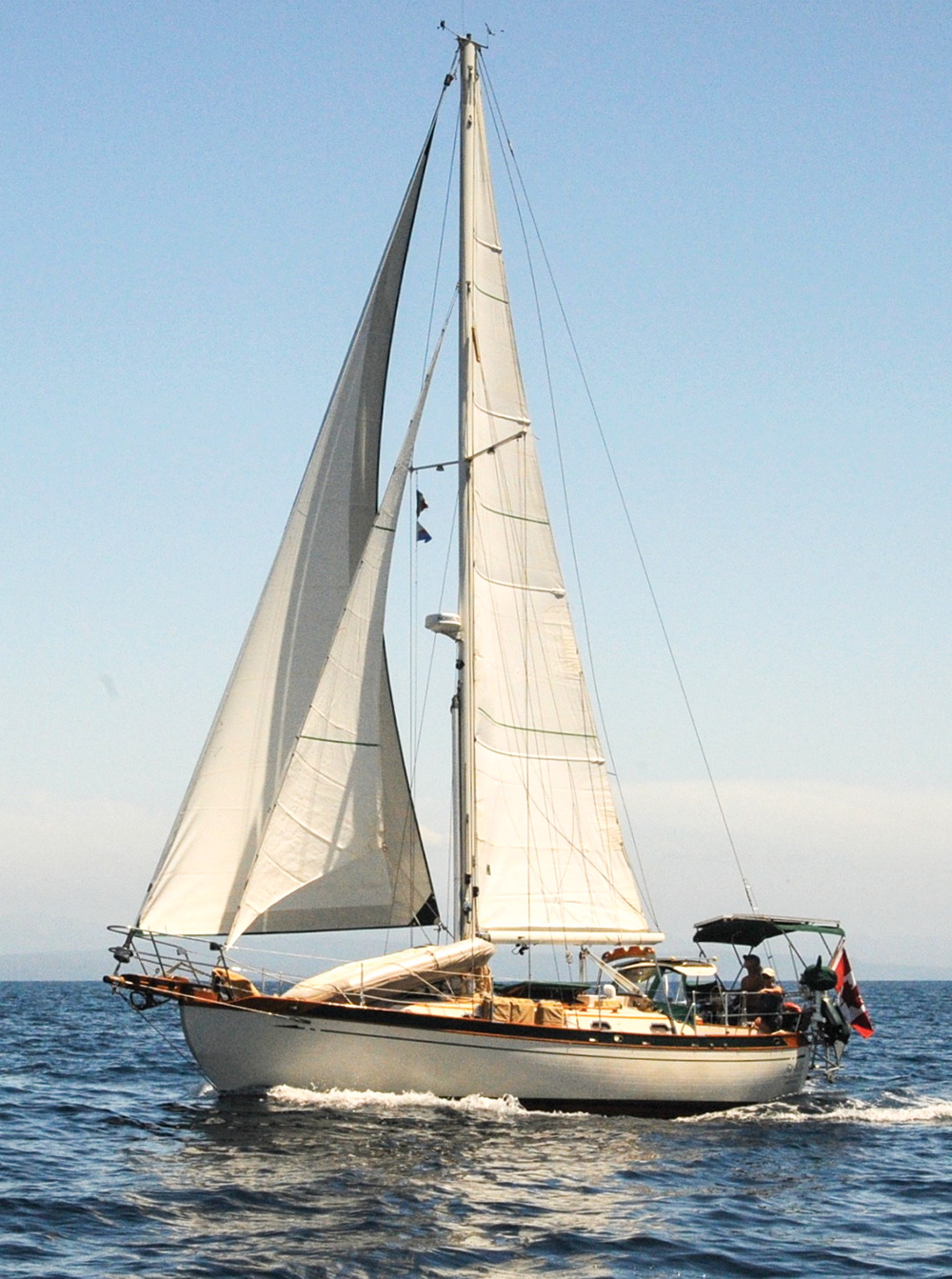
Sailors who admire the Baba 35 are quick to point out that the bluewater cruiser possesses both beauty and brawn. The full-keel, double-ended cutter was designed by naval architect Robert H. Perry. When it first splashed in 1979, the boat was dubbed the Flying Dutchman.
Three years earlier, Perry’s smaller version, the Baba 30, was launched and had acquired a strong following. But not every sailor was enamored with the Baba 30’s looks or overall sailing capabilities. The main complaint was that many of her amenities appeared crowded, the proverbial 10 pounds of peanuts in a five-pound bag. While the Baba 35 was certainly more elegant and perhaps the better sailing vessel, her coming-out party was short-lived, overshadowed in 1980 by the introduction of the Baba 40.
During the 1970s and 1980s, a small group of Taiwanese boatyards gained a reputation for masterful craftsmanship and solid construction. Among these was the Ta Shing Boatbuilding Co. in Tainan, Taiwan, where the Baba yachts were built. The small yard had attracted the attention of developer Bob Berg who, at that time, was a partner in the Flying Dutchman dealership on the West Coast. Once it became evident that sailors liked Perry’s 30-footer, Berg requested the designer draft a larger version. Perry, who had already designed the Tayana 37 that had been enthusiastically received by the world sailing community, credits Berg with the boat’s efficient layout. The new design was released as the Flying Dutchman 35, but over time that name faded away and the boat became the Baba 35.
About 72 Baba 35s were built in Formosa between 1979 and 1986, compared to the 115 Baba 40s churned out by the same boatyard from 1980 to 1982.
Despite having to contend with a showy big sister only a year after her own inaugural launch, the Baba 35 offered comfortable sailing aboard a solidly built boat that turned heads as it entered the harbor. And at 35 feet, it was less expensive to purchase and maintain than her big sister.
The Baba 35s varied slightly in design, and at least seven of the 72 hulls had pilothouses. The interiors were likely to be customized with the buyer’s preferences, although all benefitted from the superb Taiwanese carpentry and functional design.
Berg has been credited with much of the efficient interior layout, ensuring the boat had plenty of storage space and the most usable configuration of dining and sleeping quarters. On some of the boats, a hanging locker or cabinet was eliminated to make room for a quarter berth.
By 1983, the interior design had evolved so that the aluminum mast was shrouded in teak as it entered the saloon, blending it with the elegant surroundings. The head was relocated from port to starboard. The galley was fitted with a diagonally positioned sink near the base of the companionway that allowed for additional cabinets.
Boat broker Bruce Smith in Newburyport, Massachusetts, has represented the owners of various Baba 35s over the years.
“It’s so unique a boat that when people call they already know about it and are looking for that particular model,” he said, noting the yacht’s good looks and sailing capabilities are coupled with a strong build.
According to Smith, the planned 2018 around-the-world Golden Globe Race, in which the yachts will have no electronic navigation or communication devices to assist them, has brought attention to the Baba 35.
“A couple of guys are looking at one that I have because they’ve been invited to race,” he said. “The Baba 35 is probably the fastest of the bunch so far.”
Smith explained that watertight bulkheads would be installed in the boat before the race as part of the requirements.
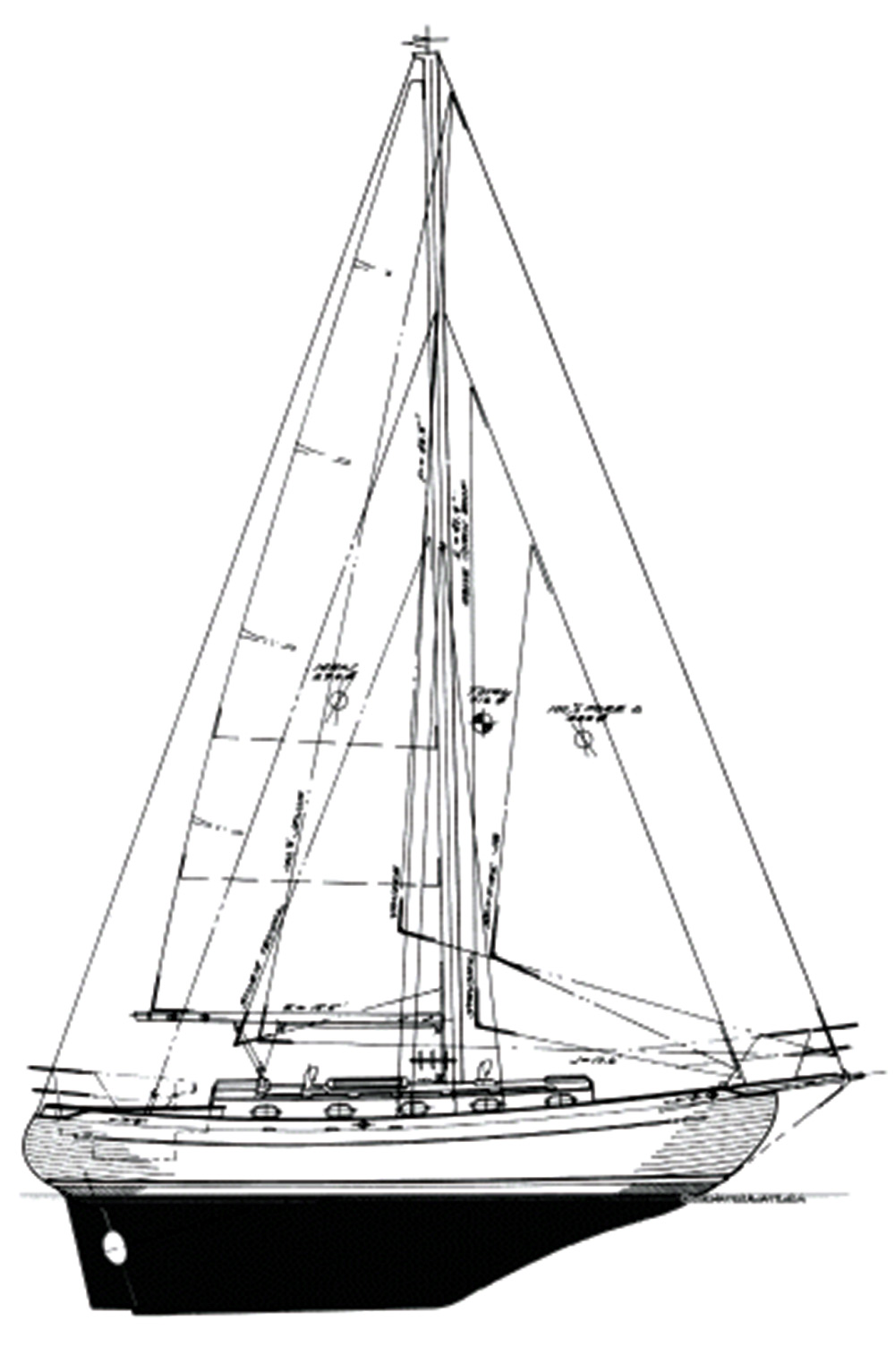
This boat can take two people around the world. That’s the first impression given off by the Baba 35, which is both beautiful and rugged. It’s impossible not to notice the heavy-duty standing rigging, bronze portals, canoe stern, elegant teak decks and the snug, gracefully wood-trimmed cockpit with its wraparound coaming. Below deck, the rich teak and masterful wood joinery can leave classic boat aficionados speechless.
Construction
The Baba 35 boasts sound construction. The boat has a fiberglass hull, deck and cabintrunk, the deck overlaid with teak. The full keel is lead-weighted. Rigging and tankage are stainless steel. Many fittings are bronze.
What to look for
Like any older boat, the Baba 35 has its issues. The teak decks may have started to leak. “Leaky teaky” is the term some owners use. The holly sole is prone to delamination. The steel fuel tanks very likely will corrode over time and require replacement. Potential buyers often find the through-hull fittings and the standing rigging, including the chainplates, have reached the end of their usefulness. Some owners have repaired or replaced the bowsprit due to rot. Hull blistering is common, which usually requires deep sanding or peeling and the application of a new barrier coat. Engine problems often depend on how well the previous owner maintained the machinery. Owners who have repowered report having to raise the original exhaust height, which means sacrificing space above the engine.
The Baba 35 cockpit is outfitted with a binnacle compass and wheel steering, and is protected by a dodger. The cutter has adequate space along the rails for crew to move to the foredeck and back. The standing rigging is dependent upon an aluminum mast and boom. The rounded cockpit is comfortable and dry. Winches and mainsheet are strategically placed for easy reach.
Anne and Dick Woodson, owners of the 1984 Baba 35 Full & By , removed the main traveler and replaced it with a double-sheeted, 5-to-1 mainsheet system.
“I’m 70 years old and I can sail the boat downwind easily without having to wake up my husband for every tack change during the night,” she said.
Once down the companionway, sailors are greeted with masterful teak woodwork and cabinetry. The overall effect is of snug comfort in salty surroundings. To starboard, there’s a navigation station with shelves and hinged chart table storage. To port, the galley features a stove and oven, double-basin stainless sink, adequate counter space and storage lockers. Refrigeration or icebox depends on the owner.
The saloon has a settee on each side with a folding table that converts to a double berth. The Baba 35 offers plenty of ventilation from a forward hatch, dorades and bronze portals that open. Headroom in the saloon is 6 feet, 4 inches.
The number of berths can vary by boat. Some configurations call for three singles and one double berth, allowing more room for a hanging locker or additional storage compartments. Other layouts provide six berths—two doubles and two singles. The head has a shower and sink. The stainless steel freshwater tank typically holds 100 gallons.
Most of the original Baba 35s were fitted out with a Perkins 4108 four-cylinder diesel engine. The diesel was rated for approximately 35 to 50 horsepower. Some of the boats were built with Universal diesels. After more than 30 years, many have been replaced with Yanmar and Volvo engines. Fuel capacity typically varies between 62 and 70 gallons.
Woodson is a firm believer in the yacht’s bluewater sailing capabilities, having cruised the West Coast from Canada to Mexico.
“She sails beautifully and is easily balanced so both the Autohelm and Monitor wind vane work well even in heavy following seas,” she said.
Woodson noted the boat sails nicely at 30 to 40 degrees off the wind and is easy to reef.
“The spinnaker is our light-air sail. In as little as 6 knots we can sail at 4 knots,” she said.
Owners tend to agree that the Baba 35 points remarkably well in all directions but best on a reach.
“She can definitely take more than the owners. The harder it blows, the better she sails,” said Jim Swallow, owner of the Baba 35 Lizard .
The Baba 35 is a functional, aesthetically pleasing and affordable bluewater boat capable of taking sailors around the world in comfort and style.
SAILING ’s Value Guide
(5-sailboat rating system)
PRICE: The price of a used Baba 35 can range from about $60,000 to $125,000, depending mostly on condition since the overall production run spanned only seven years. ★ ★ ★
DESIGN QUALITY: Robert Perry designed the Baba 35 as a bluewater cruiser. The double-ender with its canoe stern has a traditional full keel. Critics have called the hull exquisitely proportioned. The Baba 35 interior is often cited as an example of quality craftsmanship and sensible design. ★ ★ ★ ★
CONSTRUCTION QUALITY: The Baba 35 was built by the Ta Shing Boat Building Company LTD in Tainan, Taiwan. During the 1970s and 1980s, the boatyard maintained a reputation for sound construction. Materials used throughout were of the best quality and the interior woodworking, including the joinery, remains among the most impressive in the industry. Owners have described the overall construction as “rock solid.” ★ ★ ★ ½
USER-FRIENDLINESS: By all accounts, the boat is fast and stable. It can be easily singlehanded with the appropriate rigging. ★ ★ ★
SAFETY: The boat’s full keel and heavy displacement makes this bluewater cruiser safer under sail. The boat has sturdy stanchions and bow and stern pulpits. ★ ★ ★
TYPICAL CONDITION: Reports of hull blistering, corroded fuel tanks and leaking teak decks are common among Baba 35 owners. However, even the most neglectful owners may find it difficult to damage the boat’s hardy construction. ★ ★ ★ ½
REFITTING: Replacing leaky teak decks and hull blistering can be expensive. Original parts are hard to come by. ★ ★ ½
SUPPORT: Baba owners tend to swap information online through a Yahoo group reachable by emailing [email protected]. The Baba owner’s group website is www.babaowners.org . ★ ★ ½
AVAILABILITY: Only 72 Baba 35s were built, and in early 2016, at least eight were listed for sale in the United States. Additional boats were available in the U.S. Virgin Islands and Europe. ★ ★ ★
INVESTMENT AND RESALE: The boat has maintained its value with its quality construction and steady demand by offshore sailors. ★ ★ ★ ½
OVERALL SVG RATING: ★ ★ ★
Also in Used Boat Notebook
- Hunter Passage 42
- Pearson Rhodes 41
- Santa Cruz 52
- Allied Princess 36
- Kelly-Peterson 46
Also from David Liscio
- Chasing a dream
- The wide, wide world of multihulls
- Flares are expired. Now what?
- Saved from the scrap heap
- Pedal to the Medal

- Compare Sailboats
- Sailboat Calculators
- Bluewater Sailboats
- Catamarans and Multihulls
- Sailing Liveaboard
- Sailboats Galley
- How Much it Costs
- Sailing Destinations
- Meteorology Terms
- Sailing and Nautical Terms
- Parts of a Sailboat
- Great Explorers
- People of the Seas
Bluewater Sailboat – Baba 35
Also called: flying dutchman 35, fd35, ta shing 35.
This classically designed full-keel double ender by Robert H. Perry’s design team originally went by the name Flying Dutchman 35, but it is now more commonly referred to as the Bluewater Sailboat Baba 35. One of Perry’s most attractive double-enders, it has exquisitely proportioned lines that make many people fall in love with it.
In terms of both size and flavor, she falls between the three Baba boats. The Baba 40 serves the role of the swift and opulent traveler, while the Baba 30, is the chubby go-anywhere liveaboard. Ta Shing, Taiwan’s top boatyard from the 1970s to 1980s, is the maker of all of these vessels. They have established a solid reputation for decency at sea, sturdy construction, and some of the highest-quality interiors available aboard cruising yachts even today.

- LOD: 34′ 11″
- LWL: 29′ 8″
- Beam: 11′ 2″
- Draft: 5′ 6″
- Displacement: 21,140 lbs.**
- Ballast: 8,000 lbs.
- Sail Area: 716 sq. ft.
- Engine: Yanmar 33 hp
- Fuel: 75 US Gal.
- Water: 100 US. Gal.
- Designer: Robert H. Perry
- Builder: Ta Shing, Taiwan
- First Introduced: 1979
- Year Ended: 1986
- Total Built: 75
- Also Known As: Flying Dutchman 35, FD35, Ta Shing 35
- ** Owners report their boats weigh well in excess of 28,000 lbs. in cruising trim. Both Perry and Tim Ellis report the boats came in on weight ex-factory.
Bob Berg, who created the Baba series of boats, was a partner in the Flying Dutchman boat dealership on the West Coast at the time. Berg was the first to see the possibilities in a small Taiwanese yard called Shing Sheng, which had transitioned from building fishing boats to producing yachts with a half-tonner for the Japanese market. Although the boat had some success, happily, this wasn’t the case when Shing Sheng began building Berg’s Baba 30. The boats were constructed with remarkable quality, and Perry’s concept was a success.
Due to this success, the little boatyard was able to ramp up operations in 1979 and change its name to Ta Shing while also acquiring new, purpose-built facilities. In order to compete with his earlier Tayana 37 design, which was selling in significant quantities, Berg approached Perry at this time. Strangely, this new commission was given the Flying Dutchman 35 designation rather than Baba 35. The term “Baba 35” does appear in later promotional materials, and it is this name that has gained popularity.
In the original Shing Sheng workshop, the boat was lofted. Berg’s production manager Tim Ellis says, “The flat part of the stem did not blend perfectly with the pointed part of the stem beneath it, which was one particular problem with the lines. After carefully examining the lines and offsets, choose to add a chine to the stem’s intersection with the flat. It provides the bow a distinctive aspect.” The project went successfully aside from this and a trim issue that required Perry to make a change to fix a significant list.
A few pilothouse versions of the well-liked aft cockpit configuration were also constructed, and Perry continues to appreciate them. The Baba 40 Pilothouse incorporated a lot of the lessons learned while creating the Baba 35 Pilothouse. It is estimated that 75 boats, including 7 pilothouses, were built in all. In 1986, production was stopped. There is a hull number gap between 51 and 100, inclusive, and the hull numbers range from 002 to 126.
The Tayana 37, Perry’s most productive design in terms of production numbers, and the Baba 35 have certain similarities. In essence, her hull form represents a progression in the same direction. With the Tayana 37, Perry gave the full-keeled double-ender genre, which dates all the way back to Colin Archer’s lifeboat designs in the late-18th century, some performance. In Perry’s design, the keel and hull were attached as separate, clearly defined surfaces rather than the customary wineglass blend. The forefoot cutaway is mild with a more defined leading edge than the Tayana on the Baba 35, whose keel is still rather full.
The Baba’s deck profile and elegantly proportioned sheerline complement one other beautifully. The cabin house is small, the side decks are spacious, and Perry used a wraparound cockpit coaming from the Hans Christian 34.
The 35 will perform admirably in light air circumstances thanks to the well-canvassed rig, and of course, a cutter rig with a bowsprit is required for this sort of boat. The author of Yacht Design Perry claims that the initial tall rig might have been too large for some cruising regions, but he did have the opportunity to create a smaller rig for later boats that might be better all-around.
The outstanding interior quality is arguably the most noteworthy aspect. Ta Shing’s master joinery work and Berg’s own interior design skills produced a powerful combination. Berg was renowned for making painstaking efforts to squeeze space out of every available place. The Baba 35’s internal area is more comparable to many 40-foot yachts.
Key aspects of the interior layout offered alternatives. A double or a v-berth could be found in the forepeak, and the saloon had either straight couches with drop-leaf tables or couches with a L form that wrapped around the table on one side. Either a sea-going quarter berth or a sizable hanging locker were available further aft to starboard.
The galley, which is in the shape of a U, is to port and is the envy of larger vessels. The boat’s essential components are all conveniently accessible, allowing for good serviceability and maintenance.
Owners claim that interior modifications started around 1983. These adjustments included moving the head from port to starboard and installing a teak enclosure around the mast on all boats. Diagonally positioned galley sinks also allowed for greater cabinet space. These adjustments included modest finishing improvements like less teak in the head and a switch from the original rubbed oil finish to a lighter polyurethane finish on internal wood.
Performance
Seagoing comfort ranks highly on the list of benefits at average cruising trim, which weighs more than 28,000 lbs in a full keel displacement hull. The hull is initially supple before becoming stiffer at about 20 degrees of heel; this supple early heel tends to help the ride be mild and sea-friendly. For a full keel boat, she does not hobbyhorse much until the ends have been loaded and are well balanced in most situations.
Owners note that their boats are faster than they would anticipate despite having a large displacement. In open sea circumstances, they are capable of outsailing lighter, bigger boats on all points of sail. Although a reach is where the Bluewater Sailboat Baba 35 performs best, it also performs admirably close to the wind and noticeably takes away little leeway.
The boat sails best with a Yankee plus staysail combination, and in moderate winds, a cruising spinnaker is more practical than a big genoa. The Baba 35 comes into its own when the waves increase; in a storm, her displacement and reasonably full keel enable heaving-to in a relatively high degree of comfort. In a typical trade wind day, expect around 130 miles of sailing.
Quick guide
Have your surveyor inspect elements like chainplates and portions of balsa coring for rot, as is common with many boats older than 25 years. On most vessels, the original teak decks are still in good condition. Due to their high construction quality, the Baba 35s have aged well overall, better than other boats from this era. The majority of owners have changed the in-bilge installed mild steel fuel tanks because they have been shown to be prone to corrosion. Resale value has remained high, as it has for all boats from Ta Shing.
Now you can also precisely calculate the expenses related to boat ownership to make smart choices based on your budget and sailing needs. Use this bluewater Sailboat Calculator to explore different options and make the best decision.
If you’re looking for a used sailboat for sale, check out the Bluewater sailboat data and specs to make an informed decision. Ocean Wave Sail has data for over 10000+ boats that can help you select one to meet your sailing needs.
Subscribe to our newsletter
Don’t miss new updates on your email.
© OceanWave Sail. All Rights Reserved 2022
Terms & Conditions – Privacy Policy – Cookie Policy
About Us – Privacy Policy
- New account
Forgot your password?
Lost your password? Please enter your email address. You will receive mail with link to set new password.
Back to login
Privacy Overview
The Baba 35 is a 34.83ft cutter designed by Robert Perry and built in fiberglass by Ta Shing Yacht Building Ltd. between 1979 and 1986.
72 units have been built..
The Baba 35 is a heavy sailboat which is slightly under powered. It is stable / stiff and has an excellent righting capability if capsized. It is best suited as a heavy bluewater cruising boat. The fuel capacity is average. There is a good water supply range.
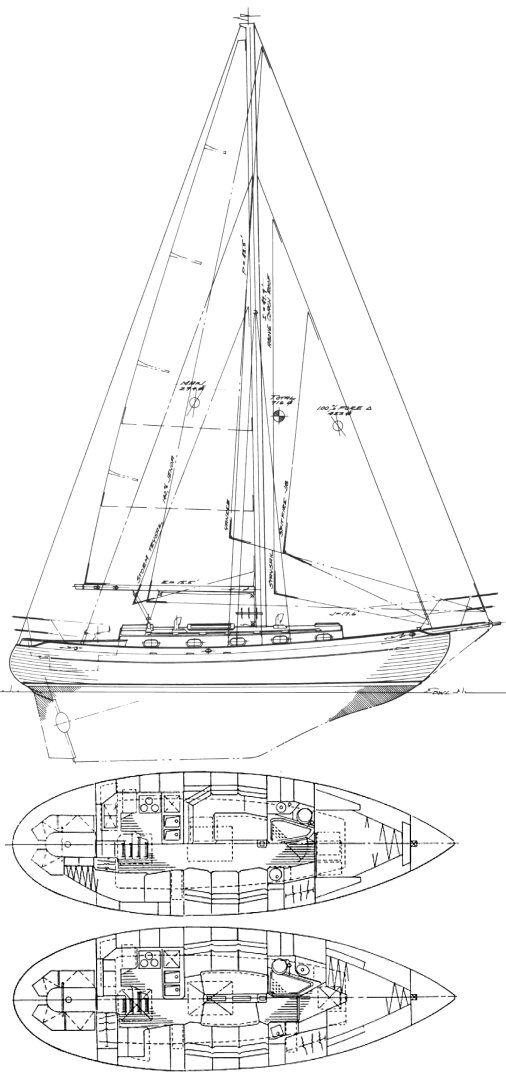
Baba 35 for sale elsewhere on the web:

Main features
Login or register to personnalize this screen.
You will be able to pin external links of your choice.

See how Sailboatlab works in video

We help you build your own hydraulic steering system - Lecomble & Schmitt
Accommodations
Builder data, modal title.
The content of your modal.
Personalize your sailboat data sheet
Boats for Sale & Yachts
Ta shing 35' flying dutchman (baba) 1979 boats for sale & yachts, ta shing 35′ boats review and specs.
Table of Contents
Designed by Robert Perry and built by TA Shing Shipyard in Taiwan. The BABA 35 is a high quality, heavy weather, long distance cruiser. Capable of round the world adventure to its highest degree.Extremely safe and comfortable, this sailing yacht has many years of enjoyment ahead of her. Do not miss this opportunity to experience the awesome power of the Flying Dutchman BABA 35.
Contact Information
Ta Shing Boats for Sale Craigslist & Ta Shing Specs & Pictures
Incoming search terms.
- baba sailboats
Related posts:
- Ta Shing Baba 1983
- Baba Ta Shing Flying Dutchman cutter 1982
- Baba/Flying Dutchman Baba 30 1980
- Ta Shing Baba 1979
This entry was posted filed under All Boats . You can follow any responses to this entry through the RSS 2.0 feed. You can skip to the end and leave a response. Pinging is currently not allowed.

- Forum Listing
- Marketplace
- Advanced Search
- About The Boat
- Boat Review Forum
- SailNet is a forum community dedicated to Sailing enthusiasts. Come join the discussion about sailing, modifications, classifieds, troubleshooting, repairs, reviews, maintenance, and more!
Baba 35 vs Tayana 37 vs Hans Christian 38
- Add to quote
- Baba 35 - asking $90,000
- Tayana 37 - asking $120,000
- Hans Christian 38 - asking $110,000
- Value for money given the asking price
- Resale value.
- Popularity (also for resale)
- Which would be fastest ( i know they are all slow)
- Maintenance upkeep. (I know they all have lots of teak)
- Sailing performance, comfort at sea, motion etc
- overall design, ease of use
- And last but not least and probably the most contentious....which has the most beauty
Those prices seem aggressive to me. Stateside they seem cheaper. I like that class of boat . I Own a Union Polaris 36 and still like it, now 20 years on. I'd like to have looked at the Hans Christian details, but there is no way I will log on to a foreign website just to see it. I would avoid a ship with a pilot house like that though. I would be wary of it tolerating a big wave impact. They are not slow ships if the wind is blowing. In light airs they are not fast, but if the wind is right there is nothing slow about them. Be wary of teak decks though. They leak. I have been living with deck leaks for 20 years. Also check the tanks too. Tiawanese ships had a dreadful reputation for poor tankage and i speak from bitter personal experience. What about welding stainless steel tanks with steel welding rods? Sound silly to you? Not in Tioawan. It would have been unreal to me, until I saw it with my own eyes on my own ship. A catastrophic error and unbelievably difficult to recover from that one. Be careful. Fill the tanks to the brim and watch the bilge for days until you are sure they are not leaking. If they leak at all, run!
Thanks for the reply. You right about the price, but i do not have the option to shop in North America where the prices are good. The Tayana has sold so I am now down to comparing the Baba35 and the Hans Christian 38T. A quick comparison on Yachtworld shows these vessels are not the cheapest ones for sale but also not the most expensive. Seems to priced about right. The Average Hans Christian 38T is priced 80-130 and the average is about 120,000. Of the Baba 35's on the Market the average price is 90,000. The one I am looking at seems to have a fair amount of equipment. The Baba 35 sounds like it has new stainless tanks (15 gallon baffled professionally produced stainless steel fuel tank with large inspection port. 80 gallons fresh water in two baffled stainless steel tanks with large inspection ports.) The Hans Christian 38T is 3 feet longer than the Baba 35 so I guess I would be getting a little more boat for the money.... Any more advice or input welcome.
I own a Tayana 37, so take this with a grain of salt. The Baba is probably a better constructed boat, but she's also heavier for her size. Same goes for the HC, I believe. Realize the T37 is out of the picture now, but I would say she's the best sailor of the three (and caveat: I have not actually sailed on the Baba). For build quality, I would have gone for the Baba, but she has the lowest SA/D of the three, therefore probably not the best sailor. The Tayana 37 is well built, but there are some issues that you should be aware of -- moot point now that she's out of the running. Between your two choices, if the $20K is not an issue, I'd go with the HC though.
If you can get your hand on a Tashiba 36 you probably beat the sailing properties of the Tayana 37, and have the superior build quality. Only problem is they are very difficult to get hold off them as only so few were produced.
Sail Calculator Pro v3.53 - 2500+ boats This website has a good comparison chart. Just scroll down and choose the two boats you want to compare. I think the Hans Christian would be the better sailor, although I'm not sure if the staysail is used in the SA/D calculation, so the numbers can be deceiving. They are both great boats, if you find a few to look at it may come down to their condition. Find one that's the best outfitted for what you want and has the newer sails, rigging and tank upgrades. I'm jealous, I wish it were a decision I had to make ;-)
I haven't sailed any of those, so I'll refrain from giving my aesthetically-based opinion. But I do hope to someday be presented with such an appealing dilema as deciding between a Baba 35, HC38t and a Tayana 37!
I have just been comparing the HC38 and T37 myself. With both companies still in business you really can't go wrong either way for resale value. When you look at numbers built HC38 167 (including 30 Telstar Keel versions), T37 588 Baba 35 75. Around 1983 the T37 comes in MKII version with an aft stateroom instead of a quarter berth. Also at some point Ta Yang relocated forward in the fore peak the fuel tank, a full tank weighing 700 pounds so far forward resulted in trim problems and hobby-horsing. The variations on the HC38 are as mysterious as the sea itself. Baba35 variations have interior layout options in key areas. In the forepeak was either a v-berth or a double, while in the saloon there were either straight settees with a drop-leaf table or a L-shaped settee on one side wrapping around the table. Further aft to starboard the option was either a sea-going quarter berth or a generously sized hanging locker. The mild steel fuel tanks have proven susceptible to corrosion mounted in the bilge. HC38 Theoretical hull speed: 7.7 knots, T37 Theoretical hull speed: 7.46 knots, Baba35 Theoretical hull speed: 7.3 knots
All three are 'leaky teakies' and are overpriced IMHO. All three are getting to that age where deck replacement and tank replacements are due both are really expensive jobs. I would have liked the HC the most I think.
Disregard TQA's stupid generality. The Baba 35, aka Flying Dutchman 35, is by far the better built boat of the three. It sails about the same as the Tayana 37. But it's shorter so off the wind the TY 37 may be a hair faster. Not sure about the HC. Not too keen on some of their construction details though. I can't speak to how the HC sails but obviosly I have more faith in my own designs. The hull forms of the Baba 35 and the TY 37 are very similar. I would say from a value perspective the Baba 35 is the best boat on your list.
Sorry Bob for criticizing your baby but the facts speak. The Baba 35s have a history of problems with the mild steel fuel tanks and replacement is not easy. I believe they have teak decks laid on a balsa cored fibre glass deck. As the last Baba 35 was built in 1986 [ I think ] that deck will be at least 27 years old. OK maybe the owners have been really carefull with the deck upkeep but not all do. Correct me if I am wrong but is the deck teak overlay not screwed down onto the fibreglass deck? So we have how many holes leading into the core? I looked long and hard at a lot of boats from that era when I was on the hunt for my forever boat. I listened to a lot of cruisers with boats from that era and the problems they had encountered. Over and over again I heard about leaking teak decks and the costs of repair. Also the nightmare of trying to replace fuel and water tanks that were installed before the deck went on. The OP asked about resale value. Try and sell a boat with a leaking diesel tank, a wornout teak deck on a soggy deck core and evidence down below of water leaks. There is an HC for sale just now in the PNW at a reduced price. Why is the price reduced who knows? Might just be related to the [ admitted ] soggy deck core. BTW I have been lucky enough to have been inside both a Baba 35 and a HC 38.I just liked the extra space in the HC but I am 6'3".
I know this does not answer your question, but you might want to add the Rafiki-37 to your potential list. They tend to list slightly lower than the others on your list, but in my unbiased opinion, fit well within your group.
Join the Tayana Owners Group ( TOG) a goggle group organization. Many of the the T37's sell from private parties. The listed price you quote is way to high. TOG will help you identify all the issues with this boat. I've owned hull number for 60 18 years. A boat for a lifetime....
TQA: You have your facts but I don't think they are "universal" they are just your "facts". Kind of like your "leaky Teak" comment. I have a fact too. My pal Donn has a beautiful PH Baba 35 with no deck problems at all. He bought this boat two years ago in reasonable condition. It's a great boat. He now has it in tip top shape.
Been through all the so called problems on my T37. Easily solved by a bit of elbow grease and a few bucks. We took off the last of the teak deck on the coach roof in January/February while at anchor in Thailand. Sure lots of small holes to fill, core in excellent shape as I had kept up with the deck seems and plugs. Same with the Black Iron tank, cut that sucker out with a sawzall in New Zealand. New tanks in bilge and under port and starboard settee's, better weight distribution etc. Any of these boats are going to require some work. Better the devil you know then.... Suggest you pay a little more for a well cared boat. If you don't love working on boats then something with a little less teak and a lot more plastic may suit you better.
Correct me if I am wrong but is the deck teak overlay not screwed down onto the fibreglass deck? So we have how many holes leading into the core? Actually, I was surprised how few screws had penetrated the core. A screw guide must have been used when applying the teak decks. Uniform penetration of the screws into the fiberglass was the norm. I drilled out every hole and filled with epoxy.
had a t37 and loved it. stainless not the best but very solid ride. ?Have you thought of adding a cape George to your list.
As folks dig up and comment on a one yr old thread, as if the op is still looking? who know, they maybe.......... at the end of the day, if the boat floats your view points, buy it! I'd rather have an islander 28 than a baba, tayana, hc style boat!
Good choice!
Some random pictures so far... I uploaded a few pictures here. Hope to add me and write some words soon. She needs a tidy up and a scrub, but overall is very sound. The Adventures of Noorderzon or - The Adventures of Noorderzon enjoy
biggles72 said: Some random pictures so far... I uploaded a few pictures here. Hope to add me and write some words soon. She needs a tidy up and a scrub, but overall is very sound. The Adventures of Noorderzon or - The Adventures of Noorderzon enjoy Click to expand...
Your HC38 Looks fantastic. Great cruising area for your new sailboat. Love the pics.
- ?
- 174K members
Top Contributors this Month

- WHY LIST WITH US?
- Shows & Events
- YOUTUBE CHANNEL
- TESTIMONIALS
- Shows & Events
A Boat Owner’s Insights – Baba 35 Double Ended Cutter
A Boat Owner’s Insights – Baba 35 Double Ended Cutter
In this segment of “A Boat Owner’s Insights,” we feature a 1979 Baba 35 Double Ended Cutter. This A Boat Owner’s Insights – Baba 35 Offshore Cutter is listed for sale on our Waterline Boats / Boatshed Seattle websites (direct link below).
Discover Your Own Special Spots Sailing this Baba 35 Double Ended Cutter
Time aboard the USCGC Eagle, a U.S. Coast Guard operated 295-foot tall ship, is intended to train Coast Guard cadets in seamanship and knowledge of the seas. For the owner of this boat, a former Coast Guard officer, time aboard USCGC Eagle did not only that but also stoked a passion for sailing that eventually resulted in the purchase of this Baba 35 Double Ended Cutter Offshore Cutter Blue Water Vessel.
With a strong mariner background like his, it’s no wonder that this owner chose such a capable and proven vessel. Quite a rarity that the boat has stayed with a single owner since it’s construction in 1979, his careful attention and care has kept the vessel in first-class condition. Currently listed with Waterline Boats, this Baba 35 Double Ended Cutter is prepared and ready for new owners to discover their own special sailing spots!
For this edition of a Boat Owner’s Insight we asked the owner some questions about this fine sailing yacht, and had the chance to learn first-hand about the design and particulars.
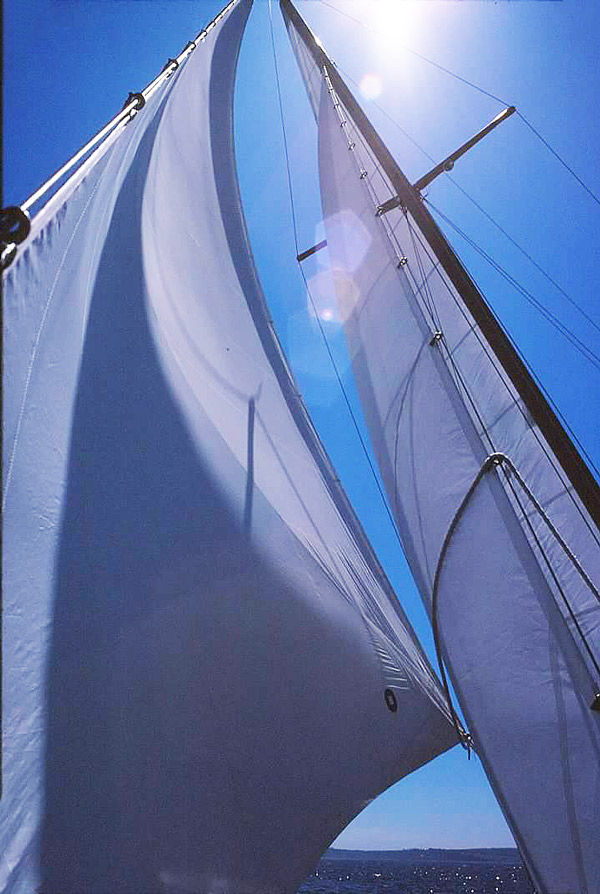
Why did you originally buy this boat?
I purchased her in 1979, at age 29. I moved to Seattle in the mid-1970s, after serving as an officer, teaching marine science for a few years in the US Coast Guard Academy in Connecticut. During my Coast Guard service, I had the opportunity to sail on the USCGC Eagle , a square-rig sailing ship used for cadet training. I gained a considerable sailing and seamanship experience, and a keen interest in yacht cruising.
The Baba-35 met my criteria: a sturdy cruising yacht designed by a highly regarded naval architect, classic lines, and ample space for a live-aboard, including headroom for someone 6’3”! My vessel is hull #003 of this design. Construction started in 1978 and she was delivered to Seattle January 1979.
What have you most enjoyed about this sailing yacht?
The original sail plan was a simple cutter rig, and she was delightful to sail. Several years later I converted the headsail rigging to a roller-furling jib. That first year, I met a lovely woman, and our first date was a weekend on the boat. She loved the roomy interior and stowage space, and we both adored being out on the water. The rest is history – we got married the following year and the boat was a major part of our lives since, cruising every summer as our two kids were growing up.
Now, after more than 40 years and many adventures together, we have reluctantly decided to let her go to new owners, whom we assume will adore and care for her as much as we have, as our focus changes to retirement, travel and visiting family overseas.
What notable destinations have you sailed to?
We live in central Puget Sound, and usually cruised north to Port Townsend, Juan de Fuca Strait, San Juan Islands, Canadian Gulf Islands, Victoria, BC, Vancouver, Nanaimo, Desolation Sound, and north along the BC coast inside of Vancouver Island.
We discovered many favorite stops along the way: marinas, resorts, anchorages in protected coves and bays, beach walks, and island hiking trails.
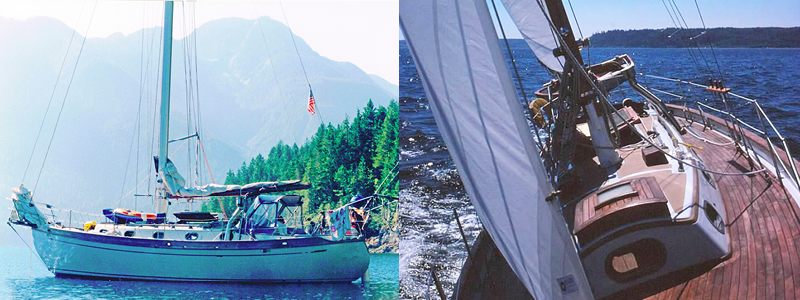
Can you list what has most impressed you about its performance?
• The boat is quite stable and sails well close-hauled to windward. • For downwind sailing we have a whisker pole. • The engine is quite efficient (35hp Yanmar diesel), and with about 55-gal fuel capacity, we could usually manage a 2-3-week cruise to the north with just one or two fuel stops. • Cruising speed is typically about 6 to 6.5 knots. • With a ¾ keel, it is quite maneuverable. • The turning radius is about one boat-length. • She rides easily with a side-swell; gentle surge rather than roll.
Did you make any additions to your boat that are unique or notable?
At the outset, I installed a Dickinson Pacific diesel stove. This was to provide for dry cabin heat in the winter as well as for cooking. The stove has an oven, which has provided many a hot meal, fresh baked biscuits, pies, etc. I also went on to make the following additions:
• Hot water coils added to the stove generate hot water piped to a separate tank, to supply the galley, head and shower. • The spruce mast was originally varnished, but later it was refinished with white polyurethane paint for much easier maintenance. • As noted earlier, the headsail rig was converted to roller furling. • The boat has a complete Sunbrella cover for winter protection.
Why are you listing with Waterline Boats?
Waterline Boats was recommended by the marina owner where I moved the boat when we decided to put it on the market. There were other Waterline listings moored at that dock.
Where to Learn More
For complete listing details on this stable and accomplished sailing vessel, including over 100 large format photos as well as videos and 360 Virtual Tours, visit our Boatshed presentation: Baba 35 Double Ended Cutter Offshore Cutter Blue Water Vessel
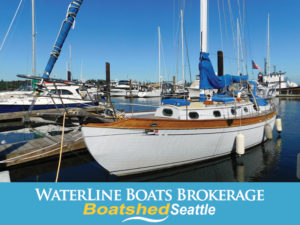
Our “A Boat Owner’s Insights” series serves to share useful and noteworthy information about the boats we currently have for sale, as relayed by their owners. This is a unique opportunity to learn intimate details and stories about the boats in our inventory from the owners themselves, and is another method by which Waterline Boats / Boatshed makes the process of buying a boat a more informative and enjoyable one. Waterline Boats – Boats For Sale Inventory

BABA 35 Detailed Review
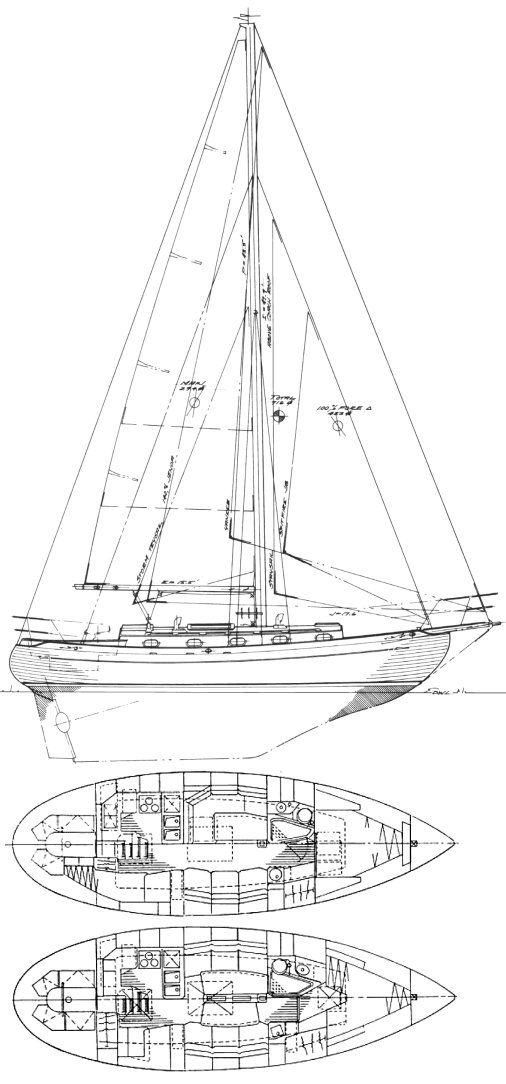
If you are a boat enthusiast looking to get more information on specs, built, make, etc. of different boats, then here is a complete review of BABA 35. Built by Ta Shing Yacht Building Ltd. and designed by Robert Perry, the boat was first built in 1979. It has a hull type of Long Keel and LOA is 10.62. Its sail area/displacement ratio 15.92. Its auxiliary power tank, manufactured by Perkins, runs on Diesel.
BABA 35 has retained its value as a result of superior building, a solid reputation, and a devoted owner base. Read on to find out more about BABA 35 and decide if it is a fit for your boating needs.
Boat Information
Boat specifications, sail boat calculation, rig and sail specs, auxillary power tank, accomodations, contributions, who designed the baba 35.
BABA 35 was designed by Robert Perry.
Who builds BABA 35?
BABA 35 is built by Ta Shing Yacht Building Ltd..
When was BABA 35 first built?
BABA 35 was first built in 1979.
How long is BABA 35?
BABA 35 is 9.02 m in length.
What is mast height on BABA 35?
BABA 35 has a mast height of 13.26 m.
Member Boats at HarborMoor
JavaScript seem to be disabled in your browser.
You must have JavaScript enabled in your browser to utilize the functionality of this website.
Edwards Yacht Sales

- 866.365.0706
1979 Baba 35
- Cape Coral, FL, US
Yacht price

- Email Broker
- Call Broker

Motive Buyer - Price Reduction!
" Linnea"is a 1979 Baba Flying Dutchman 35'
This full keel double ended blue sailor is a classic
It's a safe cruising sloop with a spacious salon
Recent Upgrades:
- New Cetrol on Brightworks 2019
- New Air conditioner 2019
- Interior cushions and mattress 2013
- Alternator new in 2017
- Transmission rebuilt 2018
- Battery Charger new 2016
- Newer Cockpit cushions
- Engine - repowered MD17 Volvo Penta approximately 2000 hours
- Boat was
- freshwater boat until 2013 and heated winter storage
Specifications
Descriptions, basic information, dimensions & weight, tank capacities, accommodations.
- View Option

This boat can take you around the world. "Linnea", is both beautiful and rugged. The solid Fiberglas hull and deck, heavy-duty standing rigging, bronze portals, canoe stern and the gracefully wood-trimmed cockpit with its wraparound coaming delivers strength, beauty, and safety.
The bimini and dodger with the comfy cockpit cushions makes this space a dry enjoyable place to be either at the dock or under sail. A classic wooden wheel helm with a Garmin 740S Chartplotter, compass, autopilot and tri-log indicators of wind depth and speed keeps you on track and proves the information needed to trim the sails for maximum performance.
The rig was change from a cutter to a sloop when the furller for the genoa was installed. Eliminating the knee knocking cutter boom and opening the fore-deck.
Manual windlass, located at the foot of the pulpit, works the forward ground tackle.
Heading down the companionway - thru the bi-winged doors and descending to a salon with masterful teak woodwork and cabinetry, a high 6'4" ceiling with a large butterfly hatch and bronze side ports, which provides a bright airy feel and beautifully appointed interior cushions and pillows will give you a "I'm at home feeling".
The staircase easily removes to expose a 2001 upgrade Volvo Penta MD17 with 35 horsepower. The engine has been maintained and have approximately 2,000 hours.
Move to the port, is the galley features a three-burner stove and oven, double-basin stainless sink, beautiful counter space and large storage lockers and a top loading refrigerator with a freezer area.
Turn and looking forward into the main salon each side has a full settee with deep blue cushion with red tubing. The table center, with storage, in the middle and have two-winged table leaves that creates a comfortable sitting for six people.
The stand out of the salon is the stain glass-work heading into the forward cabinet, it really adds a touch of elegant to this classic.
Proceeding towards the forward cabin there is a door to port that leads into the spacious head/ shower. There is another door that allows entry from the forward cabin.
The forward cabin delivers a large V berth and plenty of storage. The cushions on the V berth have been upgraded providing a very cozy and comfortable place to sleep.
Heading back aft, on the starboard side - pass the settee is the chart table with shelves for the items needed to be close at hand for navigating this vessel. The easy to access electrical panel is next to the chart table. Behind the Chart table is a single quarter berth.
This is a true classic - one of Robert Perry's best designed. The Ta Shing boatyard was world proclaimed for quality. If you are looking for a classic that is solidly built that will take you across oceans than you must see this vessel.
Watch Video:
Presented by
Mike conley 0 listing(s).

- 239.287.7213 727.449.8222
- View Profile
Manufacturer
Length Range Length Range
Year Range Year Range
Price Range Price Range
QUICK SEARCH BY:
Buyer services, featured yacht.

1985 Ocean Yachts 55 Super Sport

2001 Wellcraft Martinique 3700
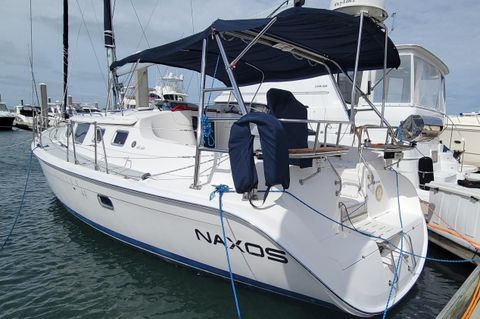
2007 Hunter 44 Deck Salon
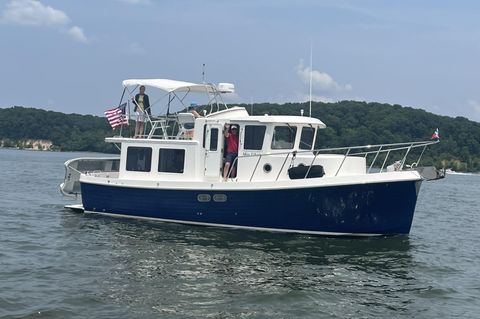
2006 American Tug 34 Pilothouse Trawler
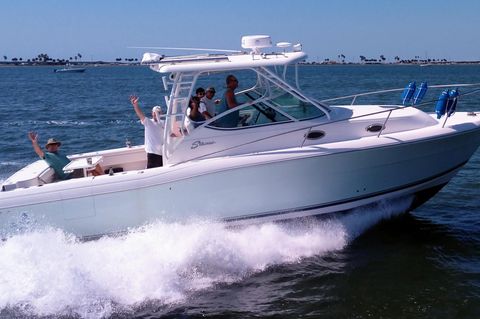
2021 Stamas 390 Aegean

1996 Tiara Yachts 3500 Express

2019 Monachus Issa 45

2007 Meridian 391 Sedan

1981 Hatteras 48 Motor Yacht

2007 Sea Ray Sundancer 40
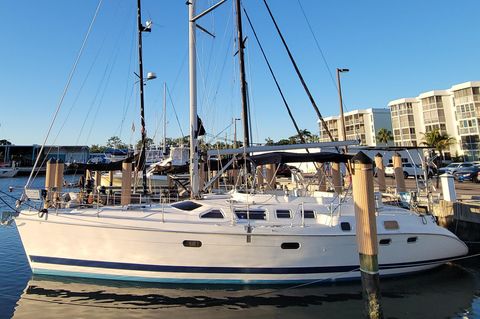
2002 Hunter 450 Passage
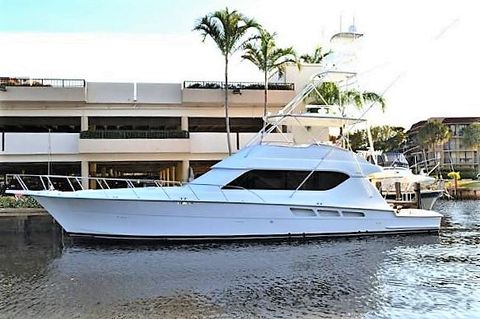
2001 Hatteras Sportfish

1985 Morgan 31 Off Shore Fishing Cuddy
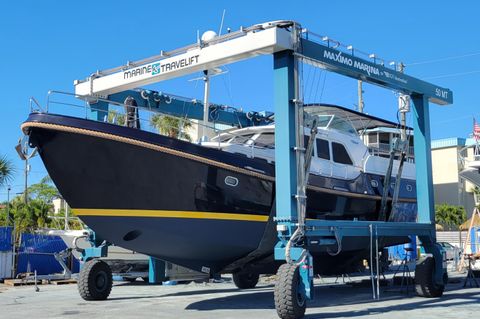
2002 Linssen 470 Grand Sturdy
- Google Plus
- Boats For Sale
- Brokerage Services
- Sold Yachts
Whether you are buying or selling your next boat or your first boat, one of Edwards Yacht Sales 45+ Professional Yacht Brokers throughout the Southeast are here to assist. Since 2003 we have acted as our clients trusted advisor throughout the entire process from shopping, to making an offer, to sea trial and survey, to closing.
Corporate Office: 510 Brookside Drive Clearwater, FL 33764
Email: [email protected]
Phone: 727.449.8222 Toll Free: 866.365.0706 Fax: 727.298.0456
Copyright © 2024 Edwards Yacht Sales Do Not Sell My Personal Information Powered by YachtCloser

We have placed cookies on your device to help make this website better.
You can use this tool to change your cookie settings. Otherwise, we’ll assume you’re OK to continue.
Some of the cookies we use are essential for the site to work.
We also use some non-essential cookies to collect information for making reports and to help us improve the site. The cookies collect information in an anonymous form.
To control third party cookies, you can also adjust your browser settings .
- New Sailboats
- Sailboats 21-30ft
- Sailboats 31-35ft
- Sailboats 36-40ft
- Sailboats Over 40ft
- Sailboats Under 21feet
- used_sailboats
- Apps and Computer Programs
- Communications
- Fishfinders
- Handheld Electronics
- Plotters MFDS Rradar
- Wind, Speed & Depth Instruments
- Anchoring Mooring
- Running Rigging
- Sails Canvas
- Standing Rigging
- Diesel Engines
- Off Grid Energy
- Cleaning Waxing
- DIY Projects
- Repair, Tools & Materials
- Spare Parts
- Tools & Gadgets
- Cabin Comfort
- Ventilation
- Footwear Apparel
- Foul Weather Gear
- Mailport & PS Advisor
- Inside Practical Sailor Blog
- Activate My Web Access
- Reset Password
- Customer Service

- Free Newsletter

Tartan 30: An Affordable Classic


Ericson 34-2 Finds Sweet Spot

How to Sell Your Boat

Cal 2-46: A Venerable Lapworth Design Brought Up to Date

Solar Panels: Go Rigid If You have the Space…

Leaping Into Lithium

The Importance of Sea State in Weather Planning

Do-it-yourself Electrical System Survey and Inspection

When Should We Retire Dyneema Stays and Running Rigging?

Rethinking MOB Prevention

Top-notch Wind Indicators

The Everlasting Multihull Trampoline

Taking Care of Your 12-Volt Lead-Acid Battery Bank

Hassle-free Pumpouts

What Your Boat and the Baltimore Super Container Ship May Have…

Check Your Shorepower System for Hidden Dangers

Waste Not is the Rule. But How Do We Get There?

How to Handle the Head

The Day Sailor’s First-Aid Kit

Choosing and Securing Seat Cushions

Cockpit Drains on Race Boats

Re-sealing the Seams on Waterproof Fabrics

Safer Sailing: Add Leg Loops to Your Harness

Waxing and Polishing Your Boat

Reducing Engine Room Noise

Tricks and Tips to Forming Do-it-yourself Rigging Terminals

Marine Toilet Maintenance Tips

Learning to Live with Plastic Boat Bits
- Sailboat Reviews
Fifteen years after the last Baba was built in Taiwan, the sailboat's traditional styling, large interior and heavy weather performance make it a favorite of cruising couples. Its principal liability is poor light air performance.
The Baba line of boats was conceived in the mid-1970’s by Bob Berg, a Seattle yacht broker who with two business associates formed Flying Dutchman International Ltd. to import traditionally styled cruising boats from Taiwan.
Bob Perry was commissioned to design the boats, which Berg envisioned as a smaller version of the Tayana 37, one of Perry’s most popular designs. Though it is a full-keeled boat, the Tayana 37 has a greater turn of speed than most traditional yachts.
“Our objective was to produce a boat that was faster and less expensive than the Westsail 32 and the Valiant 32,” Berg said. He personally designed the boat’s interior for longdistance cruising. Two versions were offered: a V-berth model, which was popular on the West Coast, and the double berth model that was popular in the East.
Berg chose a propitious time to enter the market. Production began during the heyday of the sailboat industry in 1978 and continued until 1985. More than 230 Baba 30’s were produced. During the later stages of its history, the company produced two stretch versions of the boat-theBaba 35, of which more than 50 were built, and the Baba 40, with more than 150 built. The design of the Baba 40 was reworked twice, first as the Panda 40, and later as the Tashiba 40.
The boats were built in Taiwan for three reasons, Berg said. “Ta Shing boatbuilders were among the best in the world, and the best in Taiwan. Labor was inexpensive. And we enjoyed a favorable exchange rate.”
Ta Shing also built or builds the Mason, Panda, Tashiba and Taswell yachts.
The Baba 30 was introduced with a sticker price of $38,500 in 1977. A subsequent change in the value of the dollar resulted in a price jump to $49,500. That was followed by a 40% devaluation of the Taiwanese dollar and another increase in price.
Two other factors influenced pricing: The builder switched from Volvo engines, installed on early models, to Yanmar, and spruce spars were replaced by aluminum. The last boats sold were priced at $78,000.
In addition to pricing issues, the demise of Flying Dutchman International was accelerated by two other factors: a general slump in the purchase of new boats, and a shift in buyer sentiment. During the mid-1980’s, purchasing patterns shifted to a preference for lighter, faster, sleeker-looking designs.
The Baba 30 continues to have one of the highest resale values in the marketplace. Twenty-year-old boats sell for $55,000 to $60,000; newer models for $60,000 to $65,000. Because Flying Dutchman had dealers on both coasts, the Gulf of Mexico, Great Lakes and Canada, it is possible to find used boats in most areas.
Perry’s design reflects a self-described disdain for the belief that “if it’s a traditional design it will be slow.” His objective was to take a relatively heavy, traditional double-ender and work with the hull lines to “ring every tenth of a knot in speed out of the design that I can.”
He gave the boat an easily driven hull with a prismatic coefficient of .50, “which should take care of performance in light air,” he said. The hull has considerable flair to the topsides, which enhances stability and provides a dry ride when sailing to weather.
He also flattened the bottom more than a typical Colin Archer design in an attempt to avoid hobby horsing and enhance performance. The boat has a full keel with a cutaway forefoot, so it tracks well. One owner, however, described backing up under power as “an adventure,” a typical characteristic of full-keeled boats.
Owners give the boat high marks for its sea kindly motion in all types of sea conditions. They generally agree that it suffers in light air.
Perry was equally attentive to the needs of cruisers in the design of spaces belowdecks. That concern, coupled with a pinched stern, produces a rather smallish cockpit. Its seats are 60″ long and 20″ wide, so realistically has comfortable seating for four adults. The footwell is 44″ long and 28″ wide, but useful space is diminished by the introduction of a steering pedestal. The cockpit is not large enough for sleeping comfortably, but its small size is a safety feature in the event of boarding waves. Also, there are two 2″ scuppers.
The flip side of the minimalist approach to the cockpit is an increase in space belowdecks.
“Anything shorter than 30′ is too small for a long-distance cruiser, unless you are willing to make serious compromises. At 30′, the designer still can create a workable galley, at least four full length berths, and an enclosed head,” Perry said.
The boat has 6′ 4″ headroom and a lot of stowage, even when compared to more recent 32- to 34-footers, but the price of stowage areas is a dramatic increase in displacement. The boat displaces 12,000 lb. on a 24′ 6″ waterline. Perry said that at the time he designed the Baba 30, the average 30- footer displaced about 7 ,000 lb.
“But,” he added, “you will find that the light yacht is short on stowage space, which is fine for short weekend trips and day sailing. I chose a rather beamy double-ender with a healthy displacement-to-length ratio(D/L) of 3 79, which afforded the interior volume to do a comfortable layout.”
The Baba 30 has a tall cutter rig. The sail area-to-displacement ratio (SAID) is 14.97. “While this may be viewed as a rather low figure,” he said, “it is my contention that at this size the use of a 150% genoa is not prohibitive. My aim was to design a rig compatible with the hull I had designed in terms of deriving maximum performance.”
During our test sail, we discovered that a large genoa or light air drifter contributes significantly to downwind speed in winds under 10 knots. Above 15 knots, the boat can be sailed at hull speed with a jib and staysail.
One owner told us that the boat is easily driven to weather, and will point to within 35 of apparent wind when sails are properly trimmed.
“The result of my design is not a cute cartoon,” Perry concluded, “but a really capable offshore cruising yacht.
Construction
Berg, two professional surveyors, and owners who responded to the PS Boatowner’ s Questionnaire agree that the Baba 30 is a well-constructed, blue-water vessel.
The hulls were constructed of uncored, hand-laid fiberglass using alternating layers of 1. 5-ounce mat and 24-ounce woven roving.
There are six layers in most places, and 10-12 layers in the keel area,” Berg recalled.
The interiors of early boats were smoothed and sprayed with gelcoat, and covered with a quilted vinyl material. Later models were sprayed with a foam that provided insulation and sound deadening.
Newer boats we inspected also have hulls lined with teak battens in the saloon and forepeak, which improve noise insulation and add to the boat’s traditional feel. The cabin sole is teak and holly. Cabinetry and joinery are of a quality typically associated with high-end custom yachts.
Berg disclosed that some of the hulls experienced minor blistering problems, “usually within 12″ of the waterline,” he said.
Ron Reisner, a Seattle-based surveyor and construction consultant with Reisner and McEwen, Inc., oversaw construction of Baba yachts during the 1970’s on two trips to Taiwan. He has since surveyed several used Baba 30’s, including two in 1998.
“The boats were substantially built, and have held up well,” he told us. “The only problem we have discovered is that some chainplate bolts have corroded.” Because the bolts are visible from below, their condition is easy to monitor.
Jerry Edwards, a surveyor with the same firm, concurred. Edwards sold, commissioned and performed sea trials on several boats during three years as a yacht broker, and has surveyed seven since becoming a surveyor.
“The construction is on a par with almost any quality production boat,” he said. “The electrical systems are excellent; the company used high quality wire, which was tagged and bundled. The plumbing system is also good. The blisters we saw were usually 1/8″ inch in size, and usually in small clusters near the waterline. They probably were a function of the company using isophthalic resins, rather than orthophthalic. But my main criticism of the boat is the use of a steel fuel tank.”
We inspected boats constructed in 1979 and 1983, both of which had completed trans-Pacific passages, and found no evidence of cracking or crazing on gelcoat surfaces, or of water leaks around the mast or ports. One still has a good non-skid surface on deck. On the other, its teak decks showed little wear.
The first boats produced were equipped with only one set of shrouds, Berg told us. However, after one owner’s boat was dismasted, fore and aft lower shrouds were added to the single spreader rig.
Later models incorporated a boom gallows.
Deck Layout
One of the Baba 30’s most prominent features is the 4′ bowsprit. It is surrounded by a stainless steel pulpit, and also houses two bow rollers and a large bronze winch.
Most boats were equipped with self-tending staysails, but two we inspected had been retrofitted with furlers on the jib and staysail stays, which simplified sail handling during double-handed passages across the Pacific Ocean.
The rest of the boat’s on-deck systems are rather ordinary; halyards are led to Lewmar 30 twospeed winches mounted on the cabin top, and jib sheets through blocks to Lewmar 40 two-speed winches in the cockpit. Sail tracks, port and starboard, on the coachroof, are for the stay sail sheets. The side decks are 18″ wide. The toerail is 3″ high.
Though tiny, the cockpit is functionally organized. Stowage space includes a port lazarette, two elevated, ovalshaped compartments aft that also provide a backrest for the helmsman and crew, and another vented compartment for a propane tank. Two 14″-wide cubbies with teak covers are good for stowing winch handles and other small items.
Two hatches and four bronze opening ports on each side of the cabin were standard. Two opening skylights over the saloon are 34″ long and 18″ wide; a second 24″ square hatch is located over the forepeak. Additional ventilation is through two 6″ Dorades installed in fiberglass boxes forward of the mast.
One owner mounted a spinnaker pole on a sail track on the front of the mast, which takes no otherwise usable space and eliminates the need to drill holes in the deck.
Accommodations
A number of Baba 30’s have made trans-oceanic passages, carrying adequate provisions for a crew of two. One couple spent 27 days sailing from Hawaii to Seattle.
The layout is fairly straightforward with the galley to port below the companionway, the nav station opposite, and a quarterberth to starboard. An almost triangular-shaped head is to starboard, forward of the saloon, and the V-berth fills the bow. With the exception of countertops in the galley, all of the surfaces are teak, which has aged well on the boats we saw.
The nav table is 28″ wide, and 17″ deep. A cabinet 26″ wide, 14″ high and 12″ deep is on the forward edge of the nav station and provides adequate room for VHS, GPS, ham radio or single-sideband and weatherfax. An additional 50″ x 9″ shelf provides room for books and other instruments.
The quarterberth aft of the nav station is 68″ long (plus 12″ of the nav seat) and 30″ wide and has stowage below it.
We found two interesting stowage areas under the companionway-a hanging locker immediately to starboard of the engine compartment that is large enough for two sets of foul weather gear, and another 18″ wide and 12″ high into which one owner had mounted a small microwave oven.
The engine is accessible by removing the companionway steps and cover, though some owners complain that changing oil filters is an acrobatic challenge.
The galley is a typical U-shaped affair with the ice box aft, a gimbaled two-burner stove and a dry locker and sink forward. Countertops are as large as those found on bigger boats.
Living spaces are equally spacious, partially attributable to the boat’s 10′ 6″ beam and 6′ 4″ headroom. The port settee is 6′ long and the starboard settee is 50″. Three storage compartments measuring 20″ wide, 21″ tall and 16″ deep are located on both sides of the boat, above which are enclosed cabinets more than 24″ long.
Water and fuel tanks are located below the settees.
The head is large enough to be functional but has little elbow room. It measures 31″ deep and 42″ wide, and is equipped with a circular stainless sink. The medicine cabinet is large enough for some toiletries, but too small for a cruising medical kit.
The hanging locker to port is 43″ high and 18″ wide-adequate for a small amount of clothing. We think most clothes will be stored in cabinets below the 77″ x 60″ V-berth. The chain locker/forepeak is accessed through louvered teak doors. A drawback is the water that can come aboard with the ground tackle, not to mention the smell of mud.
In our opinion, the spaces belowdecks on this boat are well-organized and adequate for couples planning extended passages, especially compared to newer production boats.
Some owners, however, report that tankage numbers are inaccurate. One told us that the fuel tank holds just 2 7 gallons, not 40 as advertised. Another said the two 40-gallon water tanks hold only 50 gallons combined.
Performance
Our experience aboard the Baba 30, corroborated by PS readers, found that in very light winds she’s an under-performer; above that, she performs on all points of sail, is sea kindly and has an easy helm.
The most cogent comments came from a couple in their mid-50’s who sailed a 1976 model from Hawaii to Seattle. After cruising Hawaiian waters for 18 months, they began the upwind route to the mainland, which took 27 days. The boat was not equipped with a spinnaker, so they used a 150% genoa in light air.
In less than 10 knots of wind the boat made 1-2 knots, steered to within 5 of its intended course for three days by an Auto-helm wind vane. When winds picked up to more than 10 knots, boat speed increased to 5 knots while sailing under the vane on a close reach. Three days from port the boat was struck by a 30-hour storm, during which winds built from 20 to 50 knots.
“The wind vane wasn’t operating properly, so we disconnected it, and steered by hand,” the skipper said. “Aside from general fatigue, we had no problems because the boat was easy to sail and the helm well-balanced; we just tied off the helm and hid behind the dodger, sailing under a double-reefed main and staysail. The ride was very comfortable. It seems as though the more the wind blew, the stouter the boat became.”
Conclusions
We think the Baba 30 will be pleasing to the eye of any sailor with an appreciation for traditional yachts. The construction methods are among the best used during its era, and have aged well; recent surveys of aging boats show them to be structurally sound. Accommodations are spacious and the joiner work is of very good quality. Performance is about what we’d expect for a boat with her displacement, so it’s no surprise that she’s sluggish in 5-10 knots of wind.
The Baba 30 has held its value well; used boats are still commanding prices nearly as high as they were 10 years ago.
RELATED ARTICLES MORE FROM AUTHOR
I’ve never seen a 30 – or any baba – with a self tending staysail, nor have i ever heard of it anywhere else. I don’t know where the number of hatches came from either : companionway, forward hatch, and 10 opening windows (all of them). Most 30s have one inline and one aft lower (though a few moved the inline lower shroud forward). Otherwise, this seems mostly accurate. Oh, several dozen hull numbers were skipped so there’s about 150 30s produced i believe.
LEAVE A REPLY Cancel reply
Log in to leave a comment
Latest Videos
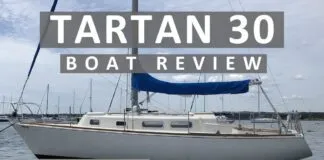
Tartan 30 | Boat Review

Fuel Contamination? The Baltimore Francis Key Bridge Collapse

Safety At Sea For You & Your Family – The Joe...

What’s The Best Vinyl Window Cleaner for Your Boat?
- Privacy Policy
- Do Not Sell My Personal Information
- Online Account Activation
- Privacy Manager

Great choice! Your favorites are temporarily saved for this session. Sign in to save them permanently, access them on any device, and receive relevant alerts.
- Sailboat Guide
Baba 30 is a 34 ′ 6 ″ / 10.5 m monohull sailboat designed by Robert Perry and built by Ta Shing Yacht Building Ltd. between 1976 and 1986.

Rig and Sails
Auxilary power, accomodations, calculations.
The theoretical maximum speed that a displacement hull can move efficiently through the water is determined by it's waterline length and displacement. It may be unable to reach this speed if the boat is underpowered or heavily loaded, though it may exceed this speed given enough power. Read more.
Classic hull speed formula:
Hull Speed = 1.34 x √LWL
Max Speed/Length ratio = 8.26 ÷ Displacement/Length ratio .311 Hull Speed = Max Speed/Length ratio x √LWL
Sail Area / Displacement Ratio
A measure of the power of the sails relative to the weight of the boat. The higher the number, the higher the performance, but the harder the boat will be to handle. This ratio is a "non-dimensional" value that facilitates comparisons between boats of different types and sizes. Read more.
SA/D = SA ÷ (D ÷ 64) 2/3
- SA : Sail area in square feet, derived by adding the mainsail area to 100% of the foretriangle area (the lateral area above the deck between the mast and the forestay).
- D : Displacement in pounds.
Ballast / Displacement Ratio
A measure of the stability of a boat's hull that suggests how well a monohull will stand up to its sails. The ballast displacement ratio indicates how much of the weight of a boat is placed for maximum stability against capsizing and is an indicator of stiffness and resistance to capsize.
Ballast / Displacement * 100
Displacement / Length Ratio
A measure of the weight of the boat relative to it's length at the waterline. The higher a boat’s D/L ratio, the more easily it will carry a load and the more comfortable its motion will be. The lower a boat's ratio is, the less power it takes to drive the boat to its nominal hull speed or beyond. Read more.
D/L = (D ÷ 2240) ÷ (0.01 x LWL)³
- D: Displacement of the boat in pounds.
- LWL: Waterline length in feet
Comfort Ratio
This ratio assess how quickly and abruptly a boat’s hull reacts to waves in a significant seaway, these being the elements of a boat’s motion most likely to cause seasickness. Read more.
Comfort ratio = D ÷ (.65 x (.7 LWL + .3 LOA) x Beam 1.33 )
- D: Displacement of the boat in pounds
- LOA: Length overall in feet
- Beam: Width of boat at the widest point in feet
Capsize Screening Formula
This formula attempts to indicate whether a given boat might be too wide and light to readily right itself after being overturned in extreme conditions. Read more.
CSV = Beam ÷ ³√(D / 64)
A collaboration between Bob Berg of Flying Dutchman, the design genius of Bob Perry and a Taiwanese boatyard that built fishing boats brought about the Baba 30, a serious go-anywhere boat packed into a diminutive 30 feet on deck. Traditionally styled, she is a beautifully proportioned double-ender with a full keel that’s a heavy weather performer. With excellent construction and a high end interior, Baba 30s have aged well, demanding a relatively high resale value and have become a favorite among cruising couples.
The Baba 30 was introduced in 1976 as a response to the unprecedented success of the Westsail 32 which with the help of a Time Magazine lifestyle feature is generally credited for creating the cruising boat boom of the 1970s.
Bob Berg of Flying Dutchman International enlisted Bob Perry to design the boat and contracted construction to a little known boatyard in Tainan City, Taiwan called Shing Sheng who’s first first foray from fishing boats to sailboats was a sophisticated 27ft racer built for a Japanese customer. The Baba 30 became the second yacht to be produced by Shing Sheng. It’s said that Perry had to kick chickens out of the way when walking to the yard in those early years. It was a place where the workers rechristened Bob Berg with the nickname “Baba”, affectionately meaning father; it was catchy enough to stick for the boat as well. By 1979 Shing Shen moved from An-Ping Quay to purpose built facilities in An-Ping Industrial Estate and a new name, “Ta Shing” was adopted.
Production ended in 1985 and although hull numbers go up to #246, there was a gap in numbering between #125 and #201 resulting in a total production count of around 170 boats. During this time the Baba 30 was joined by two other Perry designed stablemates, the Baba 35 .
The Baba 30 concept was later evolved by Bob Berg using designer Gary Grant into the Panda 34 and chose boatyard Hsin Hang to build the boat in Northern Taiwan. While Ta Shing themselves commissioned Perry to design the Tashiba 31 , an all new boat, one that Perry himself considers one of his best full keel designs, but is often mistaken as a revised Baba 30.
As a side note, in 1983 the Shing Sheng name was revived by Paul Wang, a senior partner in Ta Shing. Paul went on to build a number of Gary Grant designs including the Norseman 40 in his custom built facility in An-Ping Industrial District.
Configuration and Layout
There’s no questioning that this is a traditional full keel double-ender of Aitkens and Colin Archer heritage. The boat is nicely proportioned with beautifully balanced overhangs, a sweeping sheer, and the Perry favorite; a traditional canoe stern. A four foot bowsprit sits up front and from the mast hangs a cutter rig boasting a healthy 504 sq. ft. of sail.
John Kretschmer writing for Sailing Magazine commented, “it’s a big boat trapped in a short body” and certainly the displacement and ballast numbers are more akin to boats in the 35ft range. The cockpit is small, giving up most of the space to an expansive interior boasting 6′ 4″ of headroom. The layout down below has blue water in mind; there’s a seagoing berth and chart table combo on the starboard quarter and a large U-shaped seagoing galley to port. Two additional berths are provided in the saloon by way of settees either side of the saloon table. On some boats the table can fold away opening up the saloon, as per Perry’s original plans. The forward cabin came in two options, either a V-berth or a double berth which found favor in the East Coast. The quality of workmanship is superb and teak is abundantly used.
Construction
The Baba 30’s GRP hull follows the same layup schedule as the Valiant 32, with hull thicknesses running from just over a quarter of an inch near the topsides, to over a third of an inch near the bilges and grows to over half an inch in the tuck and keel. A single casting of iron is used as ballast which is encapsulated in GRP.
The hull to deck join is glued and through-bolted with a teak caprail sitting above the join. Early decks were cored with end-grain, kiln-dried, luan (philippine mahogany) affixed in 2 x 2 x 0.6 inch pieces, laid in filled polyester resin, later vessels utilized end-grain balsa on scrim with engineered kerfs (Baltec Contour core). Areas with through-deck fittings were locally cored in high quality marine plywood (made in Taiwan out of mahogany with waterproof glue, and boil-tested). All Baba 30 decks had a molded non-skid pattern, Thiokol-bedded teak decking was an option.
Bulkheads were of marine plywood that were staved with teak battens of 2 inches width, and much later, towards the end of production, models were available with teak veneered bulkheads as a means of reducing cost.
Early boats had wooden spars, of oregon and B.C. hemlock which do need regular care, but properly maintained will last the life of the yacht; owners tend to paint them (bad), and often do not understand that upkeep is required.
There has been an unconfirmed report of asbestos used in the galley. Tim Ellis who oversaw production of the Baba 30 from 1977 comments, “If woven asbestos was used, it was behind the stainless steel liner of the stove insert. Asbestos poses no threat in this situation and should not be disturbed. It is the handling and disposal of asbestos that requires care. To be honest, I don’t recall if we used it or not”
As a blue water cruiser, the Baba 30 will carry its crew in safety, and despite its small size, in relative comfort. The boat is well balanced and is relatively stiff. The best point of sail is on a reach with the first reef thrown in at a respectable 20 knots. In storm conditions the boat heaves-to beautifully and the boat is safe and dry.
Most owners report the boat under performs in light airs, to windward do not expect to make much headway in less than 6 knots of wind; 12-18 knots is her element. It’s worth noting Perry disagrees, commenting that the hull though pudgy, is easily driven, and under well trimmed sails can move very nicely in light airs.
Buyers Notes
As with many boats older than 25 years, have your surveyor check items such as chainplates, areas of balsa coring for rot and if applicable, the teak and the wooden mast. Overall, the Baba 30s have aged well, probably better than most boats of this era due to their excellent build quality.
Most Baba 30 owners have replaced the original mild steel 30 gallon fuel tank, which was susceptible to corrosion mounted in the bilge. The tank removes easily in half an afternoon and a new one fabricated from $600 to $1000 from a variety of materials. It’s worth noting the stainless steel water tanks and even the engine are easily removable in the Baba 30, sometimes a big job in other boats.
Resale value has remained high for a boat of its size, but when comparing with other boats in its price range, the 30 offers good value. The value of a Baba 30 will depend largely on the owner care received over the years, as of 2010 the asking price is in the range of $50k-95k USD.
It’s recommended prospective buyers contact the Baba Owners Group at for advice, they run a Yahoo discussion group that’s worth checking out.
Links, References and Further Reading
» Baba Owners Group, Baba 30 info » Baba, Panda, Tashiba sailboat Yahoo Group, information and owner discussions » Sailing Magazine, Jul 2008, Boats and Gear, A bluewater beauty that was built to last” by John Kretschmer » Practical Sailor Magazine, Nov 1998, p12-15, Used Boat Review: an in depth review of the Baba 30 » Good Old Boat Magazine, Mar 1999, Baba 30 feature
For their assistance in the writing of this article, thanks goes out to Tim Ellis who supervised the Baba line of yachts built at Shing Sheng / Ta Sheng during 1977-1987 as well as owners from the Baba Association, particularly Alan D. Sugarman. Permission to publish line drawings and notes kindly granted by Robert H. Perry.
Embed this page on your own website by copying and pasting this code.
Discover Related Sailboats

Blue Water Boats
This collection of capable blue water boats features time-tested sailboats with rich histories.

Westsail 32
Hans christian 33.

Bristol Channel Cutter

- About Sailboat Guide
©2024 Sea Time Tech, LLC
This site is protected by reCAPTCHA and the Google Privacy Policy and Terms of Service apply.

IMAGES
VIDEO
COMMENTS
It takes into consideration "reported" sail area, displacement and length at waterline. The higher the number the faster speed prediction for the boat. A cat with a number 0.6 is likely to sail 6kts in 10kts wind, a cat with a number of 0.7 is likely to sail at 7kts in 10kts wind. KSP = (Lwl*SA÷D)^0.5*0.5
Baba 35 is a 34′ 10″ / 10.6 m monohull sailboat designed by Robert Perry and built by Ta Shing Yacht Building Ltd. between 1979 and 1986. ... Though the best point of sail is on a reach, the Baba 35 is capable of excellent close to the wind performance and notably gives away little leeway.
Baba 35. SAILING's Value Guide (5-sailboat rating system) (5-sailboat rating system) PRICE: The price of a used Baba 35 can range from about $60,000 to $125,000, depending mostly on condition since the overall production run spanned only seven years. ★ ★ ★ DESIGN QUALITY: Robert Perry designed the Baba 35 as a bluewater cruiser.
Baba 35 Year: 1980 Category: Sail Condition: Used Location: Green Cove Springs, FL, US Available for sale in U.S. waters: Yes. Vessel Name: Symbioza Boat Type: Cruiser Hull Material: Fiberglass Hull Type: Hull Color: HIN: Designer: Flag of Registry: Dimensions & Weight. Length: 35 ft - 10.67 meter LOA: 34 ft 10 in - 10.62 meter
Although a reach is where the Bluewater Sailboat Baba 35 performs best, it also performs admirably close to the wind and noticeably takes away little leeway. The boat sails best with a Yankee plus staysail combination, and in moderate winds, a cruising spinnaker is more practical than a big genoa. The Baba 35 comes into its own when the waves ...
Baba boats for sale on YachtWorld are listed for a swath of prices from $25,500 on the moderate end of the spectrum, with costs up to $144,000 for the highly-specialized, bespoke models. What Baba model is the best? Some of the most popular Baba models now listed include: 30, 40 and Cutter. Baba models are available through yacht brokers ...
Seller's Description. 1986 Baba 35 cutter rig (hull 686). USCG Documented Turn key boat. Bring your personal gear, turn the key and go. Active recent sailing in Gulf of Mexico. One of the most well equipped seagoing sailboats on the market today. Hull interior, sail plan, and rig are standard with the previous addition of Profurl furling gear ...
Florida. $80,000. Description: 1986 Baba 35 cutter rig (hull 686). USCG Documented. Turn key boat. Bring your personal gear, turn the key and go. Active recent sailing in Gulf of Mexico. One of the most well equipped seagoing sailboats on the market today.
The Baba 35 is a 34.83ft cutter designed by Robert Perry and built in fiberglass by Ta Shing Yacht Building Ltd. between 1979 and 1986. 72 units have been built. The Baba 35 is a heavy sailboat which is slightly under powered. It is stable / stiff and has an excellent righting capability if capsized.
Though the best point of sail is on a reach, the Baba 35 is capable of excellent close to the wind performance and notably gives away little leeway. There is general agreement that the boat sails best with a yankee plus staysail combo, and light airs a cruising spinnaker is more useful than a large genoa. As sea conditions pick up the Baba 35 ...
Ta Shing Boats for Sale Craigslist & Ta Shing Specs & Pictures. Year: 1979. Manufacturer: Torresen Marine, Inc. - The Sailboat Specialists. Price: US$72,900. Designed by Robert Perry and built by TA Shing Shipyard in Taiwan. The BABA 35 is a high quality, heavy weather, long distance cruiser.
5'6'. Maine. $77,500. Description: Very well maintained and equipped Baba 35. Cutter rig. Present owner has owned boat for 17 years. Cruised in the northeast and Canada, and stored either indoors or covered each winter. Engine was replaced in 2016 with Beta 38. 650 hours on the meter.
Hi all, these 3 boats are my shortlisted favorites for my first yacht purchase around $100,000 USD that I can get in Asia. And they have all been favorites (I wish i could afford a Baba 40. Baba 35 - asking $90,000. Tayana 37 - asking $120,000. Hans Christian 38 - asking $110,000.
Quite a rarity that the boat has stayed with a single owner since it's construction in 1979, his careful attention and care has kept the vessel in first-class condition. Currently listed with Waterline Boats, this Baba 35 Double Ended Cutter is prepared and ready for new owners to discover their own special sailing spots!
BABA 35 Detailed Review. 1 of 1. If you are a boat enthusiast looking to get more information on specs, built, make, etc. of different boats, then here is a complete review of BABA 35. Built by Ta Shing Yacht Building Ltd. and designed by Robert Perry, the boat was first built in 1979. It has a hull type of Long Keel and LOA is 10.62.
Motive Buyer - Price Reduction! "Linnea"is a 1979 Baba Flying Dutchman 35'. Great Boat. This full keel double ended blue sailor is a classic. It's a safe cruising sloop with a spacious salon. Recent Upgrades: New Cetrol on Brightworks 2019. New Air conditioner 2019. Interior cushions and mattress 2013.
Seller's Description. Very well maintained and equipped Baba 35. Cutter rig. Present owner has owned boat for 17 years. Cruised in the northeast and Canada, and stored either indoors or covered each winter. Engine was replaced in 2016 with Beta 38. 650 hours on the meter. Equipment: Below decks autopilot; Windpilot Pacific windvane; solar panel ...
Production began during the heyday of the sailboat industry in 1978 and continued until 1985. More than 230 Baba 30's were produced. During the later stages of its history, the company produced two stretch versions of the boat-theBaba 35, of which more than 50 were built, and the Baba 40, with more than 150 built.
For Sale 1984 Baba 35 sailboat. A beautiful classic blue water cruiser, designed by Robert Perry, fully outfitted and ready to go anywhere and in excellent condition. This hard to find boat has been updated and improved throughout from the hardware and infrastructure (the captain is a retired engineer and mechanic, so you know it's been well ...
Home / Sailboat / BABA 35. BABA 35. Category: Sailboat. Boat Details. Designer: Builders: Associations: Robert Perry: Ta Shing Shipyards (TAIWAN)? # Built: Hull: Keel: 72: Long Keel? Rudder: ... What are the Best and Budget-Friendly Trailerable Sailboats in 2022? How And Where You Can Get Your Dream Sailboat For Free! Sailing around the world ...
35.5' Endeavour E35 Presently on the hard for winter storage at Morgans Marina, New Jersey Asking $35,000
Seller's Description. She is a 1980 Baba 35 that was modified to sail the Golden Globe Race 2022. Unfortunately I had an injury and could not make the start line. The boat has been recently refitted for racing the race and is in great shape for anyone to take offshore with lots of new additions. Equipment: Old sails: Main sail lightly used, 3 ...
Production ended in 1985 and although hull numbers go up to #246, there was a gap in numbering between #125 and #201 resulting in a total production count of around 170 boats. During this time the Baba 30 was joined by two other Perry designed stablemates, the Baba 35.